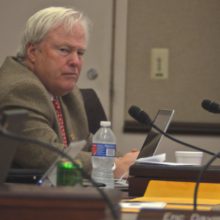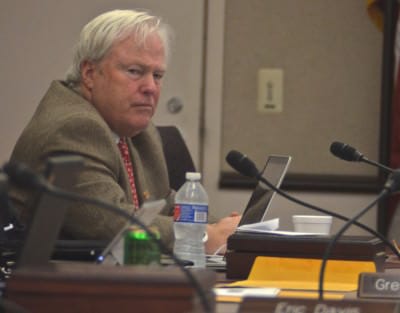

Much has been said of late — emanating from those in control in Raleigh — touting their “investment” in K-12 public education. Claims continue to be made that would have the casual observer thinking the General Assembly was a generous funder. A deeper look at the facts is important for the citizens of this once-great state who wish a return to progressive government, when funding was wisely directed toward educating our young people: for the work place, for post-secondary schooling, for life — in a marketplace that we know today continues to be more competitive on a global scale. We can’t afford to leave our young people behind.
As context, and in review of the recent past, it’s important to recall that we endured one of the deepest recessions in our nation’s history running from 2008-2011, pulling out only gradually in 2012. Dramatically falling revenues, starting in early 2008 and worsening in 2009, mandated steep reductions in the budget (N.C. wisely operates under a constitutionally-mandated balanced budget). It’s really a positive that resulting salary freezes imposed by the previous administration (mid-year 2009) were not accompanied by deeper cuts in education spending. Given that the economy didn’t markedly turn until well past 2011, frozen pay continued for several years, with only a paltry 1.2 percent increase during FY 2013. And, one needs to keep in mind that the General Assembly fell to Republican control dating to the 2010 fall elections.
Once the recovery began to hit full stride, rising revenues — instead of being channeled to play catch-up on long-deferred compensation for our state’s teachers — were diverted to accommodate the first phase of a sizable tax cut, instituted in FY 2014. Originally estimated to constitute $500 million, this series of tax cuts ultimately has translated to something closer to $800+ million. Taking that revenue stream out of the mix has seriously hampered the state’s ability to re-invest in our teachers, their professional development, textbooks, technology, etc. Long-awaited raises culminated in an average seven percent a year ago — touted to be part of a “significant” investment in K-12, but really only barely moved the needle on “purchasing power” recovery for our teachers.
And, while Republican leadership points to a billion-dollar investment in our teachers, the truth is that the majority of any cumulative five-year effort at catch-up has been not in pay or increased personnel, but rather benefits (namely, retirement fund contributions to close on a growing unfunded position, along with the increased cost of healthcare). A closer examination of the numbers would tell you that actual “added” education-related expenses on the K-12 front for the five-year period of FY09-14 were only in the $65M range. BUT note that accompanying this were offsetting cuts of a staggering $645M, producing an overall negative cumulative figure of some $585M. And this was during a time that growth in student enrollment added some 43,739 new students to our classrooms. The General Assembly was clearly focused on smaller government as opposed to a strong K-12 delivery platform for our children.
So this claim of a billion-dollar investment covered only the personnel then in place, and then mainly for benefits, while in reality, the net “investment” in K-12 plummeted. Professional development zeroed out in the continuing budget, as did technology — and a growing textbook shortage got worse and has only recently gotten any attention. Truth is we have had an increasing student population during this five-year window while we have actually spent LESS money on a per-pupil basis.
Please hear that again: we spent less in 2014-15 per pupil than we did in the 2008-09 school year.
In reality, by the end of FY14, we had 16,518 fewer personnel across the state in the schoolhouse serving our kids than was the case in FY09: 8,441 fewer teachers, 1,674 fewer teaching assistants, 827 fewer administrators, 2,304 other professionals (like counselors & librarians), and 3,272 in miscellaneous staff (custodial, cafeteria, etc). All this has been accompanied by paltry pay adjustments through time, inflation more than eating away any gains (average teacher pay actually fell during this five-year horizon by some $5,158 in REAL $ terms, as adjusted for inflation, seriously crimping a teacher’s purchasing power). In FY07, NC could proudly claim to pay its teachers 24th on the national average scale; by FY14 that number had plummeted to 47th, marking the swiftest fall in average teacher pay across the nation. How quickly our stature has fallen.
What does all this mean? For starters, we had best be worried about who fills our classrooms to teach our young people. Enrollment at schools of education in our university system is down 30 percent. Our ability to attract out-of-state teachers through reciprocity of licensure has been seriously impaired by paltry comparative pay. In 2008, we had little problem competing regionally. The profession was valued, the pay was acceptable, the state was viewed as progressive; we were able to recruit effectively. Not so today. We have a looming shortfall, facing a real pipeline problem. Between growth, retirement, and turnover, history would tell us we need approximately 10-11,000 new teachers a year. Where will we get them?
Education is a business, and I am confident the private sector would choose not to run its business this way. A fair living wage is appropriate, especially for the professionals that our teachers are. Why do the preponderance of our new teachers opt for a second job (which continues well beyond their initial hiring)? And, further, why do we fail to invest in their development, with appropriate continuing education, just as the private sector does? The same could be said for our kids, whether it’s textbooks or technology, needed tools for the teacher. The schoolhouse is being short-changed. We are paying a heavy price to generate a series of tax cuts, or to build an operating reserve at the state level through a surplus. Is this the road we want to go down? Is this the priority we wish to establish for our citizens, especially the next generation now in school? Is this any way to run a business?
I would offer an alternative. Treat our teachers as professionals. Pay them a living wage. Continue to invest in them. Deliver to our kids what they deserve. That way, we can grow the next generation to be prepared for this competitive global landscape. That is what generates jobs. That is what makes for a healthy North Carolina.


